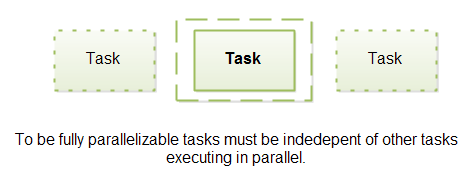Scalable Architectures
来源:互联网 发布:淘宝开店要押金吗 编辑:程序博客网 时间:2024/05/21 18:34
Scalable Architectures
A scalable architecture is an architecture that can scale up to meet increased work loads. In other words, if the work load all of a sudden exceeds the capacity of your existing software + hardware combination, you can scale up the system (software + hardware) to meet the increased work load.
可扩展架构是能满足负载日益增长的架构。或者说,如果负载超过当前系统的性能,我们可以扩展系统满足突增的负载。
Scalability Factor
When you scale up your system's hardware capacity, you want the workload it is able to handle to scale up to the same degree. If you double hardware capacity of your system, you would like your system to be able to handle double the workload too. This situation is called "linear scalability".
Linear scalability is often not the case though. Very often there is an overhead associated with scaling up, which means that when you double hardware capacity, your system can handle less than double the workload.
The extra workload your system can handle when you scale up your hardware capacity is your system's scalability factor. The scalability factor may vary depending on what part of your system you scale up.
Vertical and Horizontal Scalability
There are two primary ways to scale up a system: Vertical scaling and horizontal scaling.
Vertical scaling means that you scale up the system by deploying the software on a computer with higher capacity than the computer it is currently deployed on. The new computer may have a faster CPU, more memory, faster and larger hard disk, faster memory bus etc. than the current computer.

Horizontal scaling means that you scale up the system by adding more computers with your software deployed on. The added computers typically have about the same capacity as the current computers the system is running on, or whatever capacity you would get for the same money at the time of purchase (computers tend to get more powerful for the same money over time).

Architecture Scalability Requirements
The easiest way to scale up your software from a developer perspective is vertical scalability. You just deploy on a bigger machine, and the software performs better. However, once you get past standard hardware requirements, buying faster CPUs, bigger and faster RAM modules, bigger and faster hard disks, faster and bigger motherboards etc. gets really, really expensive compared to the extra performance you get. Also, if you add more CPUs to a computer, and your software is not explicitly implemented to take advantage of them, you will not get any increased performance out of the extra CPUs.
Scaling horizontally is not as easy seen from a software developer's perspective. In order to make your software take advantage of multiple computers (or even multiple CPUs within the same computer), your software need to be able to parallelize its tasks. In fact, the better your software is at parallelizing its tasks, the better your software scales horizontally.
Task Parallelization
Parallelization of tasks can be done at several levels:
- Distributing separate tasks onto separate computers. 【负载均衡】
- Distributing separate tasks onto separate CPUs on the same computer.【多进程】
- Distributing separate tasks onto separate threads on the same CPU. 【多线程】
You may also take advantage of special hardware the computers might have, like graphics cards with lots of CPU cores, or InfiniBand network interface cards etc.

Distributing separate tasks to separate computers is often referred to as "load balancing". Load balancing will be covered in more detail in a separate text.
Executing multiple different applications on the same computer, possible using the same CPU or using different CPUs is referred to as "multitasking". Multitasking is typically done by the operating system, so this is not something software developers need to think too much about. What you need to think about is how to break your application into smaller, independent but collaborating processes, which can also be distributed onto different CPUs or even computers if needed.
Distributing tasks inside the same application to different threads is referred to as "multithreading". I have a separate tutorial on Java Multithreading so I will not get deeper into multithreading here.
To be fully parallelizable, a task must be independent of other tasks executing in parallel with it.

To be fully distributable onto any computer, the task must contain, or be able to access, any data needed to execute the task, regardless of what computer executes the task. Exactly what that means depends on the kind of application you are developing, so I cannot get into deeper detail here.
来源于:
http://tutorials.jenkov.com/software-architecture/scalable-architectures.html
- Scalable Architectures
- Scalable Internet Architectures
- 笔记——Learning Transferable Architectures for Scalable Image Recognition
- 自学网络结构(二):Learning Transferable Architectures for Scalable Image Recognition
- Architectures 和 Valid Architectures
- scalable cacti
- GUI Architectures
- GUI Architectures
- Cell Architectures
- Architectures设置
- Architectures 相关
- Cloud Architectures
- ConvNet Architectures
- Architectures与Valid Architectures区别
- Scalable io in java
- Scalable System Design Patterns
- Scalable System Design Patterns
- Scalable System Design Patterns
- 自定义Android Action Bar,标题和按钮可以动态添加
- (四)小记
- Redmine 2.4.2 上安装backlogs 1.0.6 安装
- GIS专业就业之职业态度——转:职场人必看 十句话让您在职场少奋斗30年
- The Difference Between Trees and Hash Tables
- Scalable Architectures
- Wireshark抓包工具使用教程以及常用抓包规则
- 一些算法的MapReduce实现——1 TB数据排序源码分析
- 黑马程序员------------------String和StringBuffer
- liblas库学习笔记一
- QQ的通信协议
- Code Forces 379D New Year Letter
- 我们能从java的HelloWorld学到什么?
- 实时数据库的经典书


